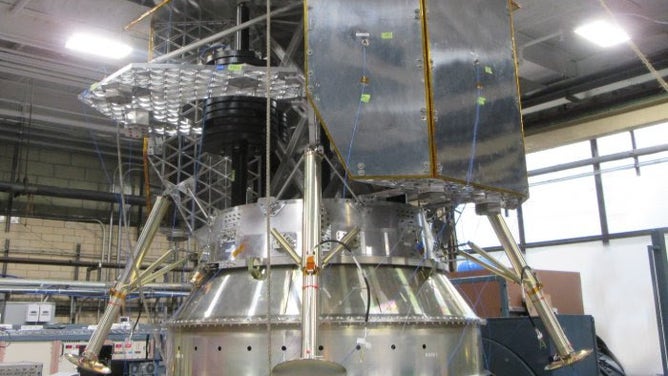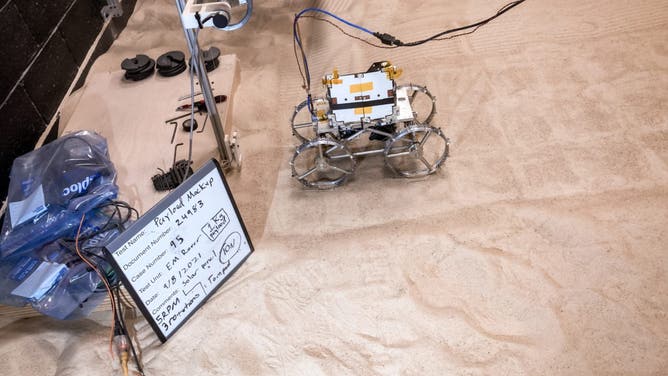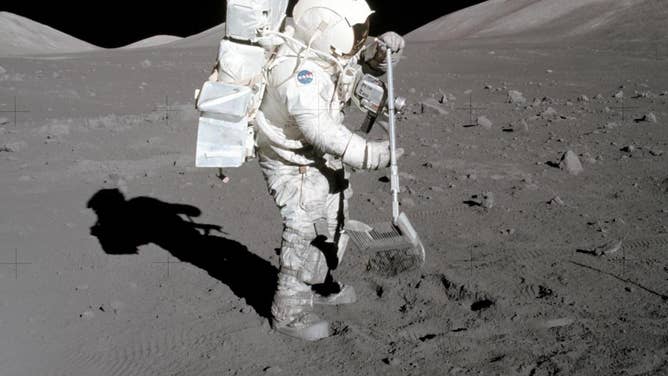A whole bunch of American-made robots are headed to the moon
Astrobotic CEO John Thornton explains how robots will prepare for human missions back to the moon.

VIPER will be delivered to the surface of the Moon in late 2023 by Astrobotic’s Griffin lander as part of NASA’s Commercial Lunar Payload Services initiative. (Image Credit: Jef Janis, NASA Glenn Research Center)
When astronauts return to the moon for the first time in 50 years, it will be a significant achievement in space exploration, but what about the robots laying the groundwork for humans' return?
While human missions get all the glory, several lesser-known American robotic missions are preparing to land on the moon, bringing NASA science designed to further human lunar exploration in the years to come.
Under NASA's Artemis program, the agency will return humans to the moon by 2025. This year, the Artemis-1 mission will test the agency's new moon rocket known as the Space Launch System and the Orion spacecraft.
Ahead of the Artemis missions, NASA selected 15 private U.S. companies to carry necessary science instruments and cargo to the moon as part of the Commercial Lunar Payload Services program, known as CLPS. The first of these robotic missions will launch this year from Florida.
"Access is affordable in ways that have never been possible before. NASA has seven missions on the manifest right now to return to the moon, all robotic, and they've gotten all those for less than a billion dollars in total. For a space agency, that's a really good price," Astrobotic CEO John Thornton said. "Typically, a mission of the moon could cost $500 (million) to $1 billion just by itself. So the fact that they're getting commercial access to the surface of the moon is a real game-changer, and that's going to open up untold possibilities for science and exploration."
GEOMAGNETIC STORM CAUSES DESTRUCTION OF 40 NEW STARLINK SATELLITES
In the second half of this year, Pittsburgh's first moon company Astrobotic will launch its Peregrine lander on a United Launch Alliance Vulcan Centaur rocket, delivering 11 NASA payloads to the lunar surface.
Astrobotic aims to be the first commercial mission to the moon, but it's just one of a whole series of missions NASA has backed to return to the moon with the help of commercial space companies.
After Peregrine lands, it will provide power and communications to all the customer payloads it brought with it, including NASA.

Astrobotic’s Peregrine lander during structural qualification testing in 2020. (Image: Astrobotic)
Thornton provides a quick summary of the NASA payloads, which are all designed to eventually help humans become a sustainable presence on the moon: "They've got things like radiation detector, they've got things looking at the soil, they've got a camera looking at how the dust interacts with the rocket plume as we're descending down to the surface. They're doing some material analysis. They're doing precursor instrument development toward finding water at the poles."
Peregrine will also have time capsules sent up as part of Astrobotic's DHL Moonbox program, where people can purchase space on the lander.
"We've got folks that are sending inscriptions of family names, and sometimes there are photos of families," Thornton said of the Moonbox payloads. "We even have some pet hair from a family pet that passed. It's all sorts of different things that individuals like you and I can send up to the surface, and that's the very first time that is possible."
There are nearly a dozen moon landers in production across the U.S. with commercial companies.
The U.S. isn't the only country with big plans for the moon. China recently approved three robotic missions to the lunar south pole, starting with the first launch in 2024.
A Chinese moon lander, Chang'e 4 and the Yutu 2 rover are currently on the far side of the moon.
NASA DELAYS ARTEMIS-1 ROCKET ROLLOUT, PUSHES LAUNCH TO LATE SPRING
Another CLPS contractor, Intuitive Machines, will launch its moon lander Nova-C with SpaceX later this year. A launch date has not been set.
Intuitive Machines has several other contracts to shuttle supplies and science to the moon for NASA. The first mission will bring about 130 kg of science instruments, and by the third mission, Nova-D, the lander will deliver up to 3.5 tons of cargo.
Also flying commercial is NASA's CubeSat CAPSTONE launching on Rocket Lab's Electron rocket from New Zealand this spring. The tiny spacecraft will orbit the moon on the same path planned for the Lunar Gateway, testing the halo orbit's stability around the moon. Gateway refers to the orbiting station where astronauts will dock before riding down to the lunar surface.
And this year's moon-bound robots are just the beginning.
Next year, Astrobotic will deliver another NASA payload, this time a rover called VIPER that will look for water on the moon's surface. Astrobotic's job is to deliver a thousand-pound rover to the moon's pole, where it will drill for water.
If you can find water at the moon, you can drink it, obviously. You can split it when you have oxygen, so you can breathe it. But perhaps most importantly, you can split water, condense it and make rocket fuel. So the moon could become a refueling station to go back and forth to the moon and then also potentially refueling station for destinations deeper in space.
Thornton said the next big thing to watch in planetary robotics is relatively small: CubeRovers.
Astrobotic is developing small-scale rovers modeled after the CubeSatetellite industry. Small-scale science payloads and cameras can be wheeled around on the moon by these shoe-box-size rovers that will rely on Wi-Fi from Astrobotic's lunar lander back at home base.

An Astrobotic CubeRover in the Lunar Regolith Lab at its headquarters in Pittsburgh, Pennsylvania. (Image credit: Astrobotic)
The incoming lunar robots will face challenges discovered during the Apollo program, including moon dust. Without an atmosphere on the moon, the dirt there is extremely sharp and sticks to everything.
"The astronauts, when they went back to the capsule after traversing down on the surface, they described the smell of the dust as almost kind of like a spent gunpowder smell. And they all actually reported a little bit of irritation in their lungs from the dust that had settled on one of the suits," Thornton said of the Apollo astronauts. "It's a very challenging environment, and we're going to need to send robots there to test the technology."
Thornton describes dust as one of the most "underappreciated challenges of going back to the moon."

Dust sticks to the boots of Apollo 17 astronaut and geologist Harrison "Jack" Schmitt in 1972. (Credit: NASA)
Astrobotic has been modeling different scenarios for landing to figure out how the dust will respond and make sure everything is sealed so the lunar dirt doesn't creep into the robot's mechanisms.
Thornton said the pesky problem of moon dust is another reason it's vital to send robots first to go deeper into space eventually.
Amid the recent number of billionaires and celebrities flying to the edge of space with space tourism companies like Blue Origin and Virgin Galactic, Thornton said it's important to remember that's a small part of space exploration.
"It's a really exciting future to start to think about space in a different way instead of thinking about it as a science and exploration and maybe a billionaire's playland," Thornton said. "It's really more, 'Hey, this could actually make a difference here on Earth.' This could really change how we think about Earth's sustainability. We could find our resources somewhere else and protect the only place in our solar system that can support life."